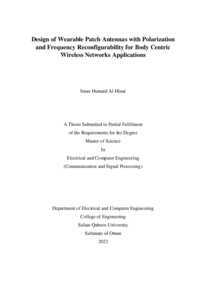Document
Design of wearable patch antennas with polarization and frequency reconfigurability for body centric wireless networks applications.
Source
Master's thesis
Country
Oman
City
Muscat
Publisher
Sultan Qaboos University
Gregorian
2023
Language
English
Thesis Type
Master's thesis
English abstract
Body Centric Wireless Networks (BCWN) communication systems are attracting the
attention of many researchers, due to their importance in many aspects. It covers an
extensive range of applications that are associated with many services. The fast
development in 5G, 6G, and the Internet of Things (IoT) make investment and research
in this area valuable. BCWN covers a wide range of applications such as Bio-medical
and health care, tracking, sports, security, entertainment, military, etc.
Wearable devices are the most important part of the BCWN. They can be worn by
humans and can communicate with other devices. It mostly consists of an antenna,
batteries, and sensors. It can be in various shapes such as bands, watches, glasses, shoes,
wearable medical sensors, helmets, etc. The main part of wearable devices is the
antenna that is used to transmit and receive signals.
BCWN includes different types of body-centric links. This MSc thesis will be focusing
on off-body links where the antenna is integrated into a wearable device and used to
transmit/receive signals to/from another antenna outside the human body.
This thesis focuses more on the design and optimization of the wearable reconfigurable
antenna. In this case, a single antenna can operate at multi-bands, polarizations, or both
by using multiple switching devices that change the status of the antenna instead of
using several antennas that make the system complex and large in size. The antenna
used in this thesis is a rectangular patch antenna with cuts at the corners connected by
PIN (Positive- Intrinsic-Negative) diodes. By turning the diodes ON and OFF, different
statuses are achieved. In this design only, by changing the statuses of the PIN diodes,
three different polarizations and four different bands of frequencies can be achieved.
The first case is when all diodes are in OFF status, the resonating frequency is at 2.45
GHz, with a bandwidth of 250 MHz (10.2%), and a gain of 4.61 dBi. The second case
is with all PIN diodes being ON states. The resonating frequency shifted to 2.2 GHz
with a gain of 2.91 dBi. Both the above-mentioned cases have linear polarization. In
Cases three and four, half of the PIN diodes are ON and half are OFF, which can achieve
resonating frequencies at 2.38 GHz and 2.37 GHz, with a gain of 4.19 dBi and 4.15 dBi
respectively. The matching bandwidth for both bands are 380 MHz (16.5%) and 390
MHz (17%) respectively. The antenna has linear polarization at the resonating
frequencies of 2.38 GHz and 2.37 GHz, and circular polarization at frequencies of 2.16
GHz, and 2.15 GHz for case three (RHCP) and case four (LHCP) respectively. Another
improvement has been achieved by introducing a slot to the first case when all PIN
diodes are in OFF status. The antenna resonating frequency shifts to the Super High
Frequency range (SHF), resonating at 3.48 GHz with a gain of 7.61 dBi. A third antenna
design was proposed as well by introducing PIN diodes to the slot gaps, seven other
cases were presented and analyzed.
Arabic abstract
تجذب أنظمة الاتصالات اللاسلكية التي تركز على الجسم (BCWN) انتباه العديد من الباحثين، كونها أحد المواضيع المثيرة للاهتمام والتي تحظى بشعبية كبيرة في الوقت الحالي وذلك لكثرة استخداماتها في العديد من التطبيقات التي تغطي خدمات مختلفة . التطورات السريعة التي يشهدها العالم في عدة جوانب منها شبكات الجيل الخامس والجيل السادس وإنترنت الأشياء (IoT) يجعل الاستثمار والبحث في هذا المجال قيمة BCWN العديد من التطبيقات مثل تطبيقات الرعاية الصحية والتتبع والرياضة والأمن والترفيه والتطبيقات العسكرية.
تعد الأجهزة القابلة للارتداء من أهم اجزاء BCWN.
تعد الأجهزة القابلة للارتداء من أهم اجزاء BCWN.
Category
Theses and Dissertations

